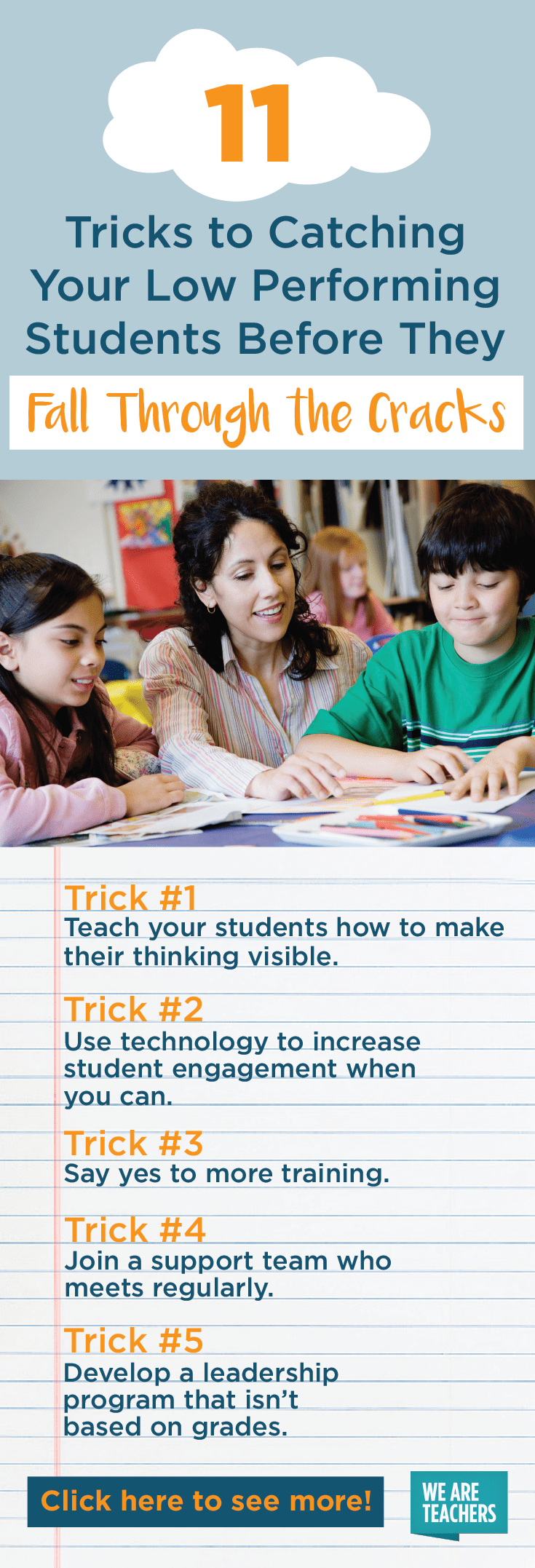Let’s be honest, class sizes are growing and standards can be difficult to track. It’s become harder and harder to catch low performing students before they fall through the cracks. Teachers who know what to look for and who track their observations tend to spot at-risk students earlier on. Here are 11 strategies for catching low performing students early enough to set them back on track.
1. Teach your students how to make their thinking visible.
Encourage them to wonder out loud and share their thoughts. Remind them to ask lots of questions, search for answers, and make connections between what they learn and what they already knew.
2. Use technology to increase student engagement when you can.
Your students will be excited to learn that they are in control of their learning. Show them how to find the videos you’ve uploaded and ask them to create their own quizzes based on what they learn. Kids need to be trusted and are more likely to share what they know when they understand that you’re in it together instead of in it to catch them doing something wrong.
3. Say yes to more training.
The more possibilities you are aware of around how to match technology to student needs, the more engaged your students will be. Anytime you get the opportunity to learn how to observe, identify, and respond to student learning, say yes. New helpful research-based tools and strategies come out all the time and can help you do your job more easily and quickly.
4. Join a support team who meets regularly.
Once you’ve identified a student who is struggling, you need to find them the help they need right away. Consider joining a group of specialists who meet regularly to brainstorm ways to support a low performing students. The more brains in the room, the better. Plus, it doesn’t hurt to know you’re not in it alone.
5. Develop a leadership program that isn’t based on grades.
Often low performing students are unable to participate in activities that build school spirit and positive self-awareness because entrance is based on excelling at academics or sports. A group that builds leaders through positive activities may be just the way to help a struggling student thrive.
6. Give students different ways to engage on a daily basis.
Teachers need to offer multiple ways for students to engage—through classroom discussion and sharing but also digital collaboration. There are many ways for students to find what feels comfortable from email to blogging to chat rooms.
7. Set up an automatic reminder guaranteeing each student one-on-one time at least once a month.
Kids need to know they are seen. When you look a child in the eye and talk about his work together, you learn so much from each other. Be sure to use your LMS to track data and give yourself reminders to keep the personal connections too. Your relationship with each student is at the heart of learning.
8. Ask students to rate themselves each quarter.
When students tell you who they are, believe them—even if you see work that is better or worse than what they are telling you about themselves. This is one of the simplest ways to discover low performing students whose grades might be hovering around benchmark.
9. Assign each student to teach something they’ve learned in the current unit.
A student can only teach something she knows well. Presenting material does not allow for under-the-radar flying.
10. Give the student a heads up.
You are about to teach a lesson and you want to see how a student will respond without causing him unnecessary anxiety. Before the lesson, let him know what question you are going to ask and that you plan to call on him. This helps you see if the student has the information but needs more processing time.
11. Be the kind of teacher kids aren’t afraid to approach.
Ultimately, the best way to make sure you catch kids before they fail is to develop relationships with them. In this way, you garner respect that leads to honesty and trust.

